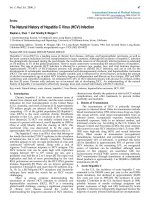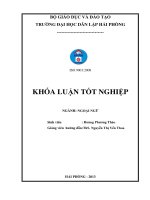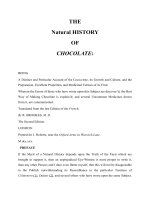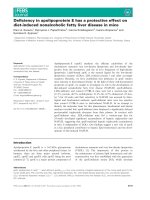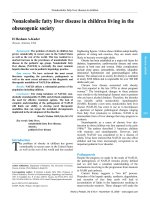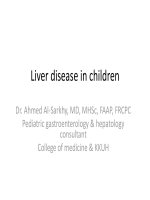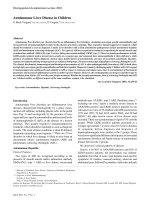The natural history of non-alcoholic fatty liver disease in children: a follow-up study for up to 20 years pptx
Bạn đang xem bản rút gọn của tài liệu. Xem và tải ngay bản đầy đủ của tài liệu tại đây (194.47 KB, 7 trang )
The natural history of non-alcoholic fatty liver disease
in children: a follow-up study for up to 20 years
A E Feldstein,
1
P Charatcharoenwitthaya,
2
S Treeprasertsuk,
2
J T Benson,
3
F B Enders,
3
P Angulo
2
See Commentary, p 1442
1
Department of Pediatric and
Adolescent Medicine, Division of
Gastroenterology and
Hepatology, Mayo Clinic,
Rochester, Minnesota, USA;
2
Department of Internal
Medicine, Division of
Gastroenterology and
Hepatology, Mayo Clinic,
Rochester, Minnesota, USA;
3
Department of Health Sciences
Research, Division of
Biostatistics, Mayo Clinic,
Rochester, Minnesota, USA
Correspondence to:
Dr P Angulo, Division of
Digestive Diseases and
Nutrition, University of Kentucky,
800 Rose Street, Rm MN469,
Lexington, KY 40536, USA;
AF is now at the Cleveland Clinic
Foundation, Pediatric
Gastroenterology and Cell
Biology, Cleveland, Ohio, USA.
Revised 22 February 2009
Accepted 1 April 2009
Published Online First
21 July 2009
ABSTRACT
Objectives: The long-term prognosis of non-alcoholic
fatty liver disease (NAFLD) in children remains uncertain.
We aimed at determining the long-term outcomes and
survival of children with NAFLD.
Design: Retrospective longitudinal hospital-based cohort
study.
Patients: Sixty-six children with NAFLD (mean age 13.9
(SD 3.9) years) were followed up for up to 20 years with
a total of 409.6 person-years of follow-up.
Results: The metabolic syndrome was present in 19
(29%) children at the time of NAFLD diagnosis with 55
(83%) presenting with at least one feature of the
metabolic syndrome including obesity, hypertension,
dyslipidaemia and/or hyperglycaemia. Four children with
baseline normal fasting glucose developed type 2
diabetes 4–11 years after NAFLD diagnosis. A total of 13
liver biopsies were obtained from five patients over a
mean of 41.4 (SD 28.8) months showing progression of
fibrosis stage in four children. During follow-up, two
children died and two underwent liver transplantation for
decompensated cirrhosis. The observed survival free of
liver transplantation was significantly shorter in the NAFLD
cohort as compared to the expected survival in the
general United States population of the same age and sex
(log-rank test, p,0.00001), with a standardised mortality
ratio of 13.6 (95% confidence interval, 3.8 to 34.8).
NAFLD recurred in the allograft in the two cases
transplanted, with one patient progressing to cirrhosis and
requiring re-transplantation.
Conclusions: Children with NAFLD may develop end-
stage liver disease with the consequent need for liver
transplantation. NAFLD in children seen in a tertiary care
centre may be associated with a significantly shorter
survival as compared to the general population.
Non-alcoholic fatty liver disease (NAFLD) is the
most common cause of chronic liver disease in the
pre-adolescent and adolescent age groups in most
of the Western world. An autopsy study found
that 9.6% of the American population aged 2–
19 years have NAFLD, and this figure increased to
38% among those who were obese.
1
Similar high
figures have been reported among children from
countries in Europe and Asia.
2–4
Insulin resistance is
almost a universal finding in paediatric NAFLD
and, consequently, several of the clinical features
associated with insulin resistance such as obesity,
diabetes mellitus and dyslipidaemia are common
comorbidities in children who suffer from
NAFLD.
5–14
NAFLD includes a wide spectrum of liver
damage ranging from simple, uncomplicated stea-
tosis to steatohepatitis to advanced fibrosis and
cirrhosis.
15 16
Several studies on the long-term
prognosis in the adult population demonstrate
that simple steatosis follows a relatively benign
clinical course
17 18
whereas steatohepatitis asso-
ciated with increased fibrosis may progress to
end-stage liver disease and its resulting complica-
tions.
18 19
Data on prognosis of NAFLD in children remain
scant. Some series have reported well-documented
cases of cirrhotic stage disease in children
120
and
other series have reported cases of children with
NAFLD who developed cirrhosis in young adult-
hood.
21 22
However, the natural history and prog-
nosis of NAFLD in children remains unknown.
Studies of children with NAFLD who underwent
long-term follow-up are necessary to better deter-
mine the natural history and long-term prognosis
of NAFLD in the paediatric population. Thus, we
conducted this cohort study aimed at determining
the long-term prognosis of children with NAFLD
and compare their survival with expected survival
of the general population of the United States of
the same age and sex.
MATERIAL AND METHODS
Study design and patient population
This was a retrospective longitudinal hospital-
based cohort study. The study was approved by
the Mayo Institutional Review Board and all
patients or responsible guardian gave written
informed consent for participation in medical
research. Paediatric patients with NAFLD were
identified using our Mayo computerised master
diagnosis index which is a database of medical
records of every patient seen at Mayo Clinic. Each
unit medical record contains all inpatient and
outpatient medical information for each patient
seen at Mayo Clinic since 1907. This has led to the
creation of a unified medical index system, the
Rochester Epidemiology Project (REP), by which
the details of the medical care provided to Mayo
patients can be studied.
23
The REP Mayo compu-
terised master diagnosis indexes all medical diag-
noses made at each health encounter by healthcare
providers at Mayo.
23
All diagnoses made in the
outpatient office or during clinic visits, hospitalisa-
tions, emergency room visits, nursing home care,
surgical procedures, autopsies and on death certi-
ficates are recorded in the database. Thus, the REP
Mayo diagnosis index makes it possible to identify
a group of patients with certain characteristics and
follow them longitudinally assessing long-term
outcomes such as mortality and causes of death.
Patients with a diagnosis of NAFLD were
identified by searching the REP master diagnostic
Hepatology
1538 Gut 2009;58:1538–1544. doi:10.1136/gut.2008.171280
index using Hospital Adaptation of International Classification
of Diseases (HICDA) codes for fatty liver, hepatic steatosis or
steatohepatitis (5710-42-42, 5710-43-1, 5710-43-0, 5470-42-0 to
4, 2790-44-1). For the purpose of this study we used the
definition of child as an individual under the age of 21 years as
proposed by the National Institutes of Health (http://grants.
nih.gov/grants/funding/children/children.htm; accessed 13
August 2009). Patients had their first medical evaluation for
their liver disease at our institution during a 15 year period from
1 January 1985 to 31 December 1999. The date 1 January 1985
was chosen since the first case of paediatric NAFLD was
reported in the mid 1980s;
20
the date 31 December 1999 was
chosen to have a 15 year ascertainment period and a follow-up
of more than 5 years for the last patient enrolled. The diagnosis
of NAFLD required (1) confirmation of diffuse fatty infiltration
of the liver in imaging studies regardless of aminotransferase
levels;(2) average daily ethanol consumption of less than 10 g;
and (3) appropriate exclusion of other liver diseases based on
standard clinical, laboratory, imaging and/or liver biopsy
features. Laboratory tests to rule out other liver diseases
included a viral hepatitis panel (for hepatitis A, B and C
performed either at the time of first evaluation or during the
follow-up), ceruloplasmin levels, a1-antitrypsin levels and
phenotype, autoantibodies (nuclear antibody (ANA), smooth
muscle antibody (SMA), antibody to the liver/kidney micro-
some type 1, and anti-mitochondrial antibody), and a standard
metabolic/inborn error panel (lactate/pyruvate ratio, urine and
serum organic acids and amino acids).
The REP master diagnostic index identified a total of 130
cases. After an extensive review of the medical records of these
patients, a total of 66 children with unequivocal NAFLD as
defined by our diagnostic criteria detailed above were identified.
A complete medical history and physical examination, and a
complete laboratory evaluation were performed in all patients
at the time of first medical evaluation in our institution and
repeated at regular intervals thereafter. Laboratory evaluation
included liver biochemistries (serum aspartate aminotransferase
(AST), alanine aminotransferase (ALT), alkaline phosphatase
activity, c-glutamyl transferase (GGT), total bilirubin, albumin
levels and prothrombin time), fasting blood glucose, fasting lipid
profiles (triglyceride, total cholesterol, HDL-cholesterol and
LDL-cholesterol levels), and specific laboratory tests to rule
other liver diseases as described before. All patients underwent
abdominal imaging with ultrasonography, computed tomogra-
phy scan, and/or magnetic resonance imaging confirming the
presence of fatty infiltration of the liver.
The body mass index (BMI) based on body weight (kilo-
grams) divided by the square of height (metres) was calculated
in every case. BMI percentile was determined according to age
and sex based on data from the Center for Disease Control and
Prevention.
24
Obesity was defined by a BMI .95
th
percentile for
age and sex.
24
Abnormalities in the fasting levels of triglycerides
and HDL-cholesterol were adjusted according to age, sex and
race or ethnic group (.95
th
percentile for triglycerides; ,5
th
percentile for HDL-cholesterol) as recommended.
25
Diabetes
mellitus was diagnosed based on standard criteria as recom-
mended by the American Diabetes Association.
26
Hypertension
was defined as a systolic or diastolic value that exceeded the 95
th
percentile for age, sex and height.
27
Hypercholesterolaemia was
defined as a fasting total cholesterol level >200 mg/dl.
28
High
LDL-cholesterol was defined by a LDL-cholesterol level
>130 mg/dl.
28
In addition, patients were classified as having the metabolic
syndrome if they met three or more of the following five criteria
for age and sex as proposed:
29
BMI above the 97
th
percentile
(which corresponds to a z-score of 2.0 or more); triglyceride level
above the 95
th
percentile; HDL cholesterol level below the 5
th
percentile; systolic or diastolic blood pressure above the 95
th
percentile; and impaired glucose tolerance. As an oral glucose
tolerance test was not performed, we used a fasting glucose
value of at least 100 mg/dl to replace impaired glucose
tolerance, as recently proposed by the International Diabetes
Federation.
30
Liver histology
A baseline liver biopsy was performed in 29 patients at the time
of diagnosis and follow-up liver biopsies in five of these patients.
Since there are no established guidelines of when to perform a
liver biopsy in patients with NAFLD, the decision to perform a
baseline liver biopsy in our patient population was made on an
individual basis by the treating gastroenterologist, and in most
(82%) cases was performed due to persistently abnormal liver
enzymes. Liver biopsy features including grade of steatosis,
inflammatory infiltrate, and ballooning, the presence of Mallory
hyaline, and stage of fibrosis were graded according to the
scoring system proposed by Kleiner et al.
31
Statistical analysis
Continuous variables are presented as mean with the standard
deviation (SD), and discrete variables are expressed as the
number (percentage) of patients with a condition. Comparisons
between patients with and without liver biopsy were performed
with two-sample t tests for continuous variables and x
2
tests for
categorical variables. Survival curves were created using the
Kaplan–Meier method. The starting point for survival analysis
was date of diagnosis of NAFLD. Patient follow-up was
extended up to April 2008. The end-points for survival analysis
were death or liver transplantation. For survival comparison we
calculated the expected number of deaths for a cohort with the
same age and sex distribution and the same amount of
observation time (exposure to death) as the 66 children with
NAFLD. The estimates were made using mortality data for
United States from the U.S. Center for Health Statistics as
previously detailed.
32
We used the relationship between the log-
rank test and the Poisson distribution. The p value calculated
(from the one-sample log-rank test) depends on the assumption
that the number of deaths follows a Poisson distribution with
an expected value equal to the expected number of deaths.
32
The
standardised mortality ratio (SMR) was calculated using the
Ederer method based on age and sex to derive the expected
number of events.
33
RESULTS
Clinical features at presentation
The main demographic and clinical features are summarised in
table 1. There was a slightly higher proportion of boys than
girls, and two-thirds were obese. Most patients had symptoms
or signs at presentation. The features of the metabolic
syndrome were common with more than half having a BMI
.97
th
percentile. Fifty-five (83.3%) children presented with at
least one feature of the metabolic syndrome whereas overt
metabolic syndrome (ie, >3 features) was present in 19 (28.8%)
children. Other features that worsen the cardiovascular risk
profile such as hypercholesterolaemia and high LDL-cholesterol
were also common. The main laboratory data gathered at the
time of NAFLD diagnosis are summarised in table 2. ALT and
AST levels were each within the normal range in few patients.
Hepatology
Gut 2009;58:1538–1544. doi:10.1136/gut.2008.171280 1539
The AST/ALT ratio was greater than 1 in 29% of children. GGT
was elevated in 88% of patients while serum alkaline
phosphatase was above the normal value for age and sex in
few patients. Serum total bilirubin, albumin and prothrombin
time were essentially within the normal range in all patients.
Positive autoantibodies in low titres were found in 20% of
patients including ANA in 15.4%, and SMA in 10% of patients.
Liver histology
The main liver biopsy features are summarised in table 3. Some
degree of fibrosis was present in 59% of children including mild
fibrosis (stage 1–2) in 11, septal/bridging fibrosis (stage 3) in
four, and cirrhotic-stage disease in two. The mean NAFLD
activity score was 3.5 (SD 1.02). Portal based injury was seen in
nine (31%) children but associated with zone 3 injury in most.
Interface hepatitis or other features suggestive of autoimmune
hepatitis were not present in any case. As summarised in table 4,
patients undergoing liver biopsy had significantly higher levels
of ALT and lower levels of total cholesterol and triglycerides;
otherwise patients undergoing liver biopsy were similar to those
who were not biopsied.
Long-term follow-up
The mean follow-up of the total cohort was 6.4 (SD 4.5) (range,
0.05–20) years, for a total of 409.6 person-years. During this time,
treatment recommendations included lifestyle modifications
consisting of an exercise programme along with diet modifications
tailored to individual need and preference alone or in eight (12.1%)
patients in combination with either ursodeoxycholic acid or
vitamin E. One year after initiation of the prescribed lifestyle
modification, 49% of children were able to lose at least 10% of
their baseline weight, and 86% of them showed significant
improvement or normalisation of aminostransferases. Neither
ursodeoxycholic acid nor vitamin E treatment appeared to impact
further the liver enzymes levels although their effect independent
of weight loss could not be assessed due to the very small number
of patients on either treatment. At the time of last follow-up,
however, most patients (76%) had re-gained weight, and in 46%
of them aminotransferases returned to baseline values.
Interestingly, four children developed type 2 diabetes 4, 6, 7 and
11 years after the diagnosis of NAFLD. Other complications that
occurred during follow-up were cholecystitis requiring cholecys-
tectomy (six patients), morbid obesity requiring bariatric surgery
(two patients), contraceptive-induced liver injury (one patient)
and bilateral oophorectomy and hysterectomy for endometriosis
(one patient).
A total of 13 liver biopsies were obtained from five patients over
a mean period of 41.4 (SD 28.8) months (table 5). The grade of
steatosis and lobular inflammation either worsened or remained
the same in all patients. Progression of fibrosis stage was
documented in four cases. One patient without fibrosis at
presentation developed stage 1 fibrosis at 19 months, and cirrhosis
(stage 4 fibrosis) at 57 months. Another patient presented
without fibrosis, but progressed to stage 1 fibrosis at 39 months,
and to stage 3 fibrosis at 82 months. Two other patients without
fibrosis at presentation progressed to stage 1 fibrosis, one at
28 months and the other at 7 months. There was no improve-
ment in any of those histological features in any case.
Long-term survival
During follow-up, two patients underwent liver transplanta-
tion, and two additional patients died. The observed number of
events in the total person-years of follow up was 4/409.6 = 9.8
per thousand. The observed number of events in the NAFLD
cohort was significantly higher than the expected number of
events in the United States population of same age and sex (4 vs
0.29416, p,0.00001) with a SMR of 13.6 (95% confidence
intervals, 3.8 to 34.8). The observed survival free of liver
transplantation in the NAFLD cohort as compared to the
expected survival of the general United States population of the
same age and sex is illustrated in fig 1.
The two patients who underwent liver transplantation were
those two who presented with cirrhosis on liver biopsy. The
first case was a Hispanic female diagnosed with cirrhotic-stage
non-alcoholic steatohepatitis (NASH) at 11 years of age, when
she presented with a BMI of 26.9 kg/m
2
, hypercholesterolaemia
and hypertriglyceridaemia. She was found with grade 3
Table 1 Demographic and clinical features at
presentation (n = 66)
Variable Mean (SD) or number (%)
Age (years) 13.9 (SD 3.9) (range, 3.2–19.6)
>10 years 55 (83.3%)
Gender (M/F) 37/29
BMI (kg/m
2
) 31.2 (SD 7.6)
Type of presentation
Asymptomatic 17 (25.8%)
Symptomatic 49 (74.2%)
Signs and symptoms*
Abdominal pain 31 (47%)
Fatigue 19 (28.8%)
Hepatomegaly 18 (27.3%)
Splenomegaly 3 (4.5%)
Acanthosis nigricans 5 (7.6%)
Associated conditions{
Obesity (BMI .95
th
percentile) 42 (65.6%)
BMI .97
th
percentile (z-score,
2.0 or more)
38 (57.6%)
Hypertriglyceridaemia 31 (47.0%)
Low HDL-cholesterol 18 (27.3%)
Hyperglycaemia 17 (25.8%)
Hypertension 8 (12.1%)
Hypercholesterolemia 27 (40.9%)
High LDL-cholesterol 15 (22.7%)
Features of metabolic
syndrome{
0 11 (16.7%)
1 or more 55 (83.3%)
2 or more 48 (72.7%)
3 or more 19 (28.8%)
*Some patients presented with more than one symptom or
associated condition.
{Hypertriglyceridaemia was defined as a level above the 95
th
percentile for age and sex; low HDL-cholesterol means a level below
the 5
th
percentile for age and sex; hypertension means a systolic or
diastolic blood pressure above the 95
th
percentile for age, sex and
height; hypercholesterolaemia means a level >200 mg/dl;
hyperglycaemia means a level of >100 mg/dl; and high LDL-
cholesterol means a level >130 mg/dl.
{The metabolic syndrome was diagnosed in patients who met three
or more of the following criteria for age and sex: a BMI above the
97
th
percentile (z-score, 2.0 or more), a triglyceride level above the
95
th
percentile, an HDL-cholesterol level below the 5
th
percentile,
systolic or diastolic blood pressure above the 95
th
percentile, and a
fasting glucose value of at least 100 mg/dl as proposed.
29 30
BMI, body mass index; F, female; HDL, high-density lipoprotein;
LDL, low-density lipoprotein; M, male.
Hepatology
1540 Gut 2009;58:1538–1544. doi:10.1136/gut.2008.171280
oesophageal varices and developed recurrent variceal bleeding
requiring variceal band ligation in multiple occasions. She
underwent liver transplantation at 20 years of age due to end-
stage liver disease and hepatopulmonary syndrome. In the post-
transplant period, she was diagnosed with recurrent NASH at
9 months, stage 1 fibrosis at 2 years and 3 months, and stage 2
fibrosis at 3 years and 3 months after liver transplantation. She
is currently alive. The second case was a white female diagnosed
with cirrhotic-stage NASH at 18.9 years of age when presented
with a BMI of 33.6 kg/m
2
, and low HDL-cholesterol. She
developed severe hypoxaemia from hepatopulmonary syndrome
without any other liver complication requiring liver transplan-
tation at 25 years of age. She was found with macrovesicular
steatosis on protocol liver biopsy as early as 14 days after liver
transplantation, with well-established NASH at 6 weeks after
liver transplantation, and with bridging fibrosis at 1 year. She
was diagnosed with cirrhotic stage NASH in the graft and
hepatopulmonary syndrome 2 years after liver transplantation,
requiring re-transplantation 2.3 years after the first liver
transplant procedure. Finally, she died from multiple organ
failure at age 27 years. The two deaths recorded were both non-
liver related, and none of these two cases had liver biopsy
performed at any time.
DISCUSSION
The study is the first to describe the long-term survival of
children with NAFLD who underwent a follow-up of up to
20 years. The study demonstrates that NAFLD in children is a
disease of progressive potential. Some children presented with
cirrhosis, others progressed to advanced fibrosis or cirrhosis
during follow-up, and some developed end-stage liver disease
with the consequent need of liver transplantation. The study
shows that NAFLD in children is associated with a significantly
shorter long-term survival as compared to the expected survival
of the general population of the same age and sex; our children
with NAFLD had a 13.8-fold higher risk of dying or requiring
liver transplantation than the general population of the same
age and sex. The two deaths recorded were not liver related, but
the inclusion of these two cases among the four cases reaching
the outcome of death or liver transplantation is appropriate as
the comparison was done to overall mortality in the general
population of same age and sex regardless of the causes of death.
The study also provides interesting data regarding the
progressive potential of NAFLD to more advanced disease.
Four of the five children with repeated liver biopsy did not have
fibrosis on diagnosis liver biopsy, but two developed mild (stage
1) fibrosis, and the other two developed advanced (stage 3–4)
fibrosis. The progression of liver damage in these patients over a
relatively short period of time highlights the importance of
Table 2 Laboratory features at presentation (n = 66)
Laboratory test Mean (SD) or proportion Range
Proportion within normal
range* (%) Normal range{
Alanine aminotransferase (U/l) 137 (102) 17–579 6 10–45
Serum aspartate aminotransferase (U/l) 94 (62) 18–326 14 26–31
Alkaline phosphatase (U/l) 435 (276) 69–1011 96 98–1276
c-Glutamytransferase (U/l) 77 (52) 25–210 12 6–31
Total bilirubin (mg/dl) 0.7 (0.6) 0.2–4.3 90 0.1–1.0
Albumin (g/dl) 4.5 (0.4) 3.6–5.2 100 3.5–5.0
Prothrombin time (s) 10.3 (1.2) 8.6–12.7 100 8.4–12.0
Cholesterol (mg/dl) 216 (76) 112–497 60.6 ,200
HDL-cholesterol 37 (11.5) 11–67 72.7 {
LDL-cholesterol 130 (49) 55–233 77.3 ,130
Triglyceride (mg/dl) 216 (168) 44–768 53 {
Glucose (mg/dl) 106 (51) 73–371 87.9 ,100
Anti-nuclear antibodies 15.4% Negative
Smooth muscle antibodies 10% Negative
*Refers to patients who had normal laboratory values considering the normal range for the specific age and sex in each individual case.
{Includes the normal laboratory values for boys and girls for the age range of our patient population.
{Based on percentile for age and sex.
ALT, alanine aminotransferase; ANA, antinuclear antibody; AST, serum aspartate aminotransferase; GGT, c-glutamyl transferase; HDL, high-density lipoprotein; LDL, low-density
lipoprotein; SAM, smooth muscle antibody.
Table 3 Liver biopsy features (n = 29)
Histological finding Number (%)
Steatosis score
0, Minimal (,5%) 0
1, Mild (.5–33%) 5 (17.2)
2, Moderate (.33% and 66%) 11 (37.9)
3, Severe (.66%) 13 (44.8)
Lobular inflammation score
0, No foci 1 (3.4)
1, Mild 26 (89.7)
2, Moderate 1 (3.4)
3, Severe 1 (3.4)
Hepatocellular ballooning
0, None 24 (82.8)
1, Few 5 (17.2)
2, Prominent 0
NAFLD activity score
1–2 5 (17.2)
3–4 20 (70)
5 or more 4 (13.8)
Fibrosis
Stage 0 12 (41.3)
Stage 1 Perisinusoidal or periportal
1A Delicate perisinusoidal 3 (10.3)
1B Dense perisinusoidal 1 (3.5)
1C Periportal only 2 (6.9)
Stage 2 Perisinusoidal and periportal 5 (17.2)
Stage 3 Bridging fibrosis 4 (13.8)
Stage 4 Cirrhosis 2 (6.9)
Mallory’s hyaline 4 (13.8)
Liver biopsy features were graded and staged according to the
scoring system proposed by Kleiner et al.
31
The grade of steatosis
(0–3), lobular inflammation (0–3), and ballooning (0–2) were then
combined to determine the non-alcoholic fatty liver disease (NAFLD)
activity score (0–8) as proposed.
31
Hepatology
Gut 2009;58:1538–1544. doi:10.1136/gut.2008.171280 1541
identifying those children with NAFLD who are at risk of
having a more progressive liver disease. In some recent series,
the presence and severity of fibrosis was consistently associated
with a higher BMI or larger waist circumference.
10 12 14
Older age
and higher levels of AST and insulin have been found associated
with fibrosis in some series
10 12
However, further studies are
needed to accurately identify those children who are more likely
to progress to end-stage liver disease.
Interestingly, the two patients in our cohort who underwent
liver transplantation had hepatopulmonary syndrome as the
main indication for transplant. However, whether or not there
is an association between progression to cirrhosis and develop-
ment of severe hepatopulmonary syndrome requiring liver
transplantation in paediatric NAFLD remains uncertain, and
further studies in this area are needed. It is also intriguing that
both cases undergoing liver transplantation in our series
developed recurrent NASH, with cirrhotic stage disease in one
patient who required re-transplantation. Recurrence of NASH
after liver transplantation in children has been documented in
two isolated cases,
34 35
both male patients of age 13 and 16 years
who developed decompensated liver disease from NAFLD. Both
patients had a history of hypothalamic/pituitary dysfunction;
in one case associated with hepatopulmonary syndrome. These
two cases
34 35
extended prior observations of the development of
severe liver disease from NAFLD in patients with hypothalamic/
pituitary dysfunction.
36
Similar to other paediatric series of NAFLD, most of our
children were diagnosed in the second decade of life; girls and
boys were affected almost equally with a slight male pre-
dominance, and most were symptomatic at presentation.
As in adults with NAFLD, a high proportion of our children
were obese and had several features associated with the
metabolic syndrome. Unlike adults, almost a third of our
children had portal-based injury on liver biopsy, but most of
them had pericentral/perisinusoidal injury as well. Two of our
children had type 2 diabetes prior to the diagnosis of NAFLD,
whereas four patients developed type 2 diabetes within 11 years
after NAFLD was diagnosed. Therefore, children with NAFLD
Table 5 Follow-up liver biopsy (n = 5)
Patient no
Interval between first and last
liver biopsy (months)
Date of liver biopsy
(month/date/year) Steatosis grade
Lobular
inflammation grade Fibrosis stage Reason to repeat the liver biopsy
1 33 First biopsy (3/1993) Moderate Mild 1 –
Second biopsy (12/1995) Moderate Mild 1 Follow-up before ursodeoxycholic acid
prescribed
2 57 First biopsy (7/1999) Mild Mild 0 –
Second biopsy (2/2001) Moderate Mild 1 Worsening of ALT levels
Last biopsy (4/2004) Severe Mild
4 Liver biopsy performed for persistently
elevated ALT and done during
laparoscopic cholecystectomy
3 82 First biopsy (12/1996) Mild Mild 0 –
Second biopsy (4/1999) Moderate Mild 1 Persistent abnormal liver tests
Last biopsy (11/2002) Moderate Moderate 3 Liver biopsy performed for persistently
elevated liver enzymes and done during
bariatric surgery
4 28 First biopsy (8/1990) Moderate Mild 0 –
Second biopsy (2/1991) Moderate Mild 0 Persistent abnormal liver tests
Third biopsy (12/1992) Moderate Mild 1 Follow-up before starting treatment with
ursodeoxycholic acid
5 7 First biopsy (14 Oct 1998) Mild 0 0 –
Second biopsy (10/1999) Mild 0 1 Laparoscopic liver biopsy during surgery
for persistent patent ductus venosis
ALT, alanine aminotransferase.
Table 4 Comparison of major variables between patients with or without liver biopsy
Variable
Liver biopsy (n =29);
mean (SD) or n (%)
No liver biopsy (n = 37);
mean (SD) or n (%) p Value
Age (years) 13.2 (4.1) 14.6 (3.7) 0.15
Male gender (male/total) 19 (65%) 18 (49%) 0.17
BMI (kg/m
2
) 30.1 (6.5) 32.1 (8.3) 0.29
Abdominal pain at presentation 13 (45%) 18 (48%) 0.76
Obesity (BMI.95
th
percentile) 18 (55%) 24 (65%) 0.96
Dyslipidaemia 10 (34%) 14 (38%) 0.78
Hypertriglyceridaemia 12 (41%) 19 (51%) 0.47
Hypercholesterolaemia 12 (41%) 14 (38%) 0.89
Hypertension 3 (10%) 5 (13%) 0.69
ALT (IU/l) 166.7 (125.8) 105.1 (54.9) 0.03
AST (IU/l) 103.3 (69.4) 87.0 (54.6) 0.29
Glucose (mg/dl) 92.9 (13.0) 117.3 (66.8) 0.09
Cholesterol (mg/dl) 193.6 (41.6) 235.4 (92.6) 0.04
Triglyceride (mg/dl) 149.9 (61.1) 272.1 (208.1) 0.007
Duration of follow-up (years) 6.2 (4.7) 6.6 (4.2) 0.73
ALT, alanine aminotransferase; AST, serum aspartate aminotransferase; BMI, body mass index.
Hepatology
1542 Gut 2009;58:1538–1544. doi:10.1136/gut.2008.171280
should be closely monitored for development of type 2 diabetes
later in life.
We found a high proportion of children (27.3%) with HDL-
cholesterol below the 5
th
percentile for their age and sex which
has not been reported in paediatric NAFLD before. Similar to
adults with NAFLD,
37
20% of our children tested positive for
low titre of ANA and/or SMA. Interestingly, the vast majority
(88%) of our children had elevated GGT with alkaline
phosphatase levels within the normal range in most of them.
To our knowledge, this high proportion of children with
elevated GGT levels has not been described in any other series
of paediatric NAFLD. Recently, higher serum levels of GGT
have been associated with several cardiovascular disease risk
factors or components of the metabolic syndrome.
38–41
GGT is
located on the external surface of most cells and mediates the
uptake of glutathione, an important component of intracellular
antioxidant defences. GGT could be informative in children
with NAFLD because its expression is enhanced by oxidative
stress and it could be released by several conditions inducing
cellular stress and insulin resistance; both insulin resistance and
oxidative stress are key components in the development of
NAFLD.
42
The main strengths of our study are the inclusion of children
with the whole spectrum of NAFLD from simple steatosis to
cirrhosis along with the long-term follow-up of up to 20 years.
The cases were well documented with all children having the
diagnosis of NAFLD confirmed by radiological findings, and in
almost half of them with liver histology. However, our study
has some limitations. First, our patients were seen in a referral
tertiary care medical centre, and although the results may be
extrapolated to other similar medical centres, the results most
likely may not apply to children with NAFLD from the
community. In this regard, larger community- or population-
based studies are necessary to determine the prognosis of
NAFLD in children from the general population. Second, most
of our children (80%) were white, and thus, whether or not the
long-term prognosis of paediatric NAFLD is any different
among the different ethnic groups needs to be investigated.
Finally, since liver biopsy is not part of the standard of care to
confirm the diagnosis of NAFLD, only about a half of our
children underwent liver biopsy and, thus, we were not able to
determine the prognostic significance of the individual histolo-
gical features.
In summary, our study demonstrates that NAFLD in children
is associated with a significantly shorter survival as compared to
survival of the general population of same age and sex. NAFLD
in children may progress to cirrhosis and end-stage liver disease
with the consequent need for liver transplantation, but NAFLD
with severe NASH may recur in the allograft. Further studies are
needed to identify those children with NAFLD who are at a
higher risk for disease progression who would be expected to
benefit the most from medical therapy.
Funding: PC was supported by a grant from the Faculty of Medicine, Siriraj Hospital,
Mahidol University, Bangkok, Thailand. ST was supported by a medical research
scholarship from the Faculty of Medicine, Chulalongkorn University, Bangkok, Thailand.
Competing interests: None.
Ethics approval: The study was approved by the Mayo Institutional Review Board on
18 June 2002.
Provenance and peer review: Not commissioned; externally peer reviewed
REFERENCES
1. Schwimmer JB, Deutsch R, Kahen T, et al. Prevalence of fatty liver in children and
adolescents. Pediatrics 2006;118:1388–93.
2. Tominaga K, Kurata JH, Chen YK, et al. prevalence of fatty liver in Japanese children
and relationship to obesity. An epidemiological ultrasonographic survey. Dig Dis Sci
1995;40:2002–9.
3. Franzese A, Vajro P, Argenziano A, et al. Liver involvement in obese children.
Ultrasonography and liver enzymes levels at diagnosis and during follow-up in an
Italian population. Dig Dis Sci 1997;42:1428–32.
4. Chan DF, Li AM, Chu WC, et al. Hepatic steatosis in obese Chinese children.
Int J Obes Relat Metab Disord 2004;28:1257–63.
5. Baldridge AD, Perez-Atayde AR, Grame-Cooke F, et al. Idiopathic steatohepatitis in
childhood: A multicenter retrospective study. J Pediatr 1995;127:700–4.
6. Franzese A, Vajro P, Argenziano A, et al. Liver involvement in obese children.
Ultrasonography and liver enzyme levels at diagnosis and during follow-up in an Italian
population. Dig Dis Sci 1997;42:1428–32.
7. Rashid M, Roberts EA. Nonalcoholic steatohepatitis in children. J Pediatric
Gastroenterol Nutr 2000;30:48–53.
8. Demir H, Kocak N, Gurakan F, et al. Obesity: a cause of steatohepatitis in children.
Am J Gastroenterol 2000;95:1366–7.
9. Manton ND, Lipsett J, Moore DJ, et al. Nonalcoholic steatohepatitis in children and
adolescents. Med J Aust 2000;173:476–9.
10. Schwimmer JB, Deutsch R, Rauch JB, et al. Obesity, insulin resistance, and other
clinicopathological correlates of pediatric nonalcoholic fatty liver disease. J Pediatr
2003;143:500–5.
11. Schwimmer JB, McGreal N, Deutsch R, et al. Influence of gender, race, and
ethnicity on suspected fatty liver in obese adolescents. Pediatrics 2005;115:e561–5.
12. Nobili V, Marcellini M, Devito R, et al. NAFLD in children: a prospective clinical–
pathological study and effect of lifestyle advice. Hepatology 2006;44:458–65.
13. Patton HM, Sirlin C, Behling C, et al. Pediatric nonalcoholic fatty liver disease: a
critical appraisal of current data and implications for future research. J Pediatr
Gastroenterol Nutr 2006;43:413–27.
14. Manco M, Marcellini M, Devito R, et al. Metabolic syndrome and liver histology in
paediatric non-alcoholic steatohepatitis. Int J Obes (Lond) 2008;32:381–7.
15. Angulo P. Nonalcoholic fatty liver disease. N Engl J Med 2002;346:1221–31.
16. Brunt EM, Janney CG, Di Bisceglie AM, et al. Nonalcoholic steatohepatitis: a
proposal for grading and staging the histological lesions. Am J Gastroenterol
1999;94:2467–74.
17. Dam-Larsen S, Franzmann M, Andersen IB, et al. Long term prognosis of fatty liver:
risk of chronic liver disease and death. Gut 2004;53:750–5.
18. Ekstedt M, Franzen LE, Mathiensen UI, et al. Long-term follow-up of patients with
NAFLD and elevated liver enzymes. Hepatology 2006;44:865–73.
19. Adams LA, Lymp JF, St Sauver J, et al. The natural history of nonalcoholic fatty liver
disease: a population-based cohort study. Gastroenterology 2005;129:113–21.
20. Kinugasa A, Tsunamoto K, Furukawa N, et al. Fatty liver and its fibrous changes
found in simple obesity of children. J Pediatr Gatroenterol Nutr 1984;3:408–14.
21. Molleston JP, White F, Teckman J, et al. Obese children with steatohepatitis can
develop cirrhosis in childhood. Am J Gastroenterol 2002;97:2460–2.
22. Suzuki D, Hashimoto E, Kaneda K, et al. Liver failure caused by non-alcoholic
steatohepatitis in an obese young male. J Gastroenterol Hepatol 2005;20:327–9.
23. Melton LJ 3rd. History of the Rochester Epidemiology Project. Mayo Clin Proc
1996;71:266–74.
24. Kuczmarski RJ, Ogden CL, Grummer-Strawn LM, et al. CDC growth charts: United
States. Adv Data 2000;8:1–27.
Figure 1 Kaplan–Meier survival curve of children with non-alcoholic
fatty liver disease (NAFLD) (n = 66) as compared to the general United
States population of same age and sex. The observed survival free of
liver transplantation was significantly shorter in the NAFLD cohort as
compared to the expected survival of the general United States
population of the same age and sex; the standarised mortality ratio was
13.6 (95% confidence intervals, 3.8 to 34.8; p,0.0001).
Hepatology
Gut 2009;58:1538–1544. doi:10.1136/gut.2008.171280 1543
25. NGHS Coordinating Center. NHLBI Growth and Health Study (NGHS) data
monitoring report. Baltimore: Maryland Medical Research, 1998.
26. American Diabetes Association. Diagnosis and Classification of Diabetes Mellitus.
Diabetes Care 2005;28(Suppl 1):S37–S42.
27. National High Blood Pressure Education Program. Update on the 1987 Task
Force Report on High Blood Pressure in Children and Adolescents: a working group
report from the National High Blood Pressure Education Program. Pediatrics
1996;98:649–58.
28. National Cholesterol Education Program. Report of the
Expert Panel on Blood Cholesterol in Children and Adolescents. Pediatrics
1998;101:141–7.
29. Weiss R, Dziura J, Burgert TS, et al. Obesity and the metabolic syndrome in children
and adolescents. N Engl J Med 2004;350:2362–74.
30. Zimmet P, Alberti G, Kaufman F, et al. The metabolic syndrome in children and
adolescents. Lancet 2007;369:2059–61.
31. Kleiner DE, Brunt EM, Van Natta M, et al. Design and validation of a
histological scoring system for nonalcoholic fatty liver disease. Hepatology
2005;41:1313–21.
32. Therneau T, Offord J. Expected survival based on hard rates (update). Rochester,
MN: Department of Health Science Research, Section of Biostatistics, Mayo Clinic;
1999, Technical Report Series No. 63.
33. Ederer F. The relative survival rate: a statistical methodology. National Cancer
Institute Monographs 1961;6:101–21.
34. Jonas MM, Krawczuk LE, Kim HB, et al. Rapid recurrence of nonalcoholic fatty liver
disease after transplantation in a child with hypopituitarism and hepatopulmonary
syndrome. Liver Transpl 2005;11:108–10.
35. Jankowska I, Socha P, Pawlowska J, et al. Recurrence of non-alcoholic
steatohepatitis after liver transplantation in a 13-yr-old boy. Pediatr Transplant
2007;11:796–8.
36. Adams LA, Feldstein A, Lindor KD, et al. Nonalcoholic fatty liver disease among
patients with hypothalamic and pituitary dysfunction. Hepatology 2004;39:909–14.
37. Adams LA, Lindor KD, Angulo P. The prevalence of autoantibodies and autoimmune
hepatitis in patients with nonalcoholic fatty liver disease. Am J Gastroenterol
2004;99:1316–20.
38. Lee DH, Ha MH, Kim JH, et al. Gamma-glutamyltransferase and diabetes—a 4 year
follow-up study. Diabetologia 2003;46:359–64.
39. Nakanishi N, Nishina K, Li W, et al. Serum gamma-glutamyltransferase and
development of impaired fasting glucose or type 2 diabetes in middle-aged Japanese
men. J Intern Med 2003;254:287–95.
40. Kim DJ, Noh JH, Cho NH, et al. Serum gamma-glutamyltransferase within its normal
concentration range is related to the presence of diabetes and cardiovascular risk
factors. Diabet Med 2005;22:1134–40.
41. Kang YH, Min HK, Son SM, et al. The association of serum gamma
glutamyltransferase with components of the metabolic syndrome in the Korean
adults. Diabetes Res Clin Pract 2007;77:306–13.
42. Day CP. From fat to inflammation. Gastroenterology 2006;130:207–10.
ANSWER
From the question on page 1466
The CT scan shows a pelvic mass abutting the sigmoid colon causing large bowel obstruction.
Histology confirmed the presence of large spherical clusters of actinomycosis colonies. This case
demonstrates a rare cause of large bowel obstruction from an ascending actinomycosis infection
caused by the IUCD.
Actinomycosis is a chronic, progressive suppurative granulomatous infection caused by a
Gram-positive, microaerophillic, filamentous bacterium.
1
This pathogen can be found as a
normal commensal in the gastrointestinal and genital tract; Actinomycosis israelii being the most
common subtype.
1
Actinomycosis classically becomes opportunistic in females with a long-term IUCD and
progresses as an ascending genital tract infection affecting both pelvic and adjacent abdominal
organs.
2
It is estimated that actinomycosis is present in 10% of asymptomatic IUCD users; this
rises to 25% in patients with genitourinary tract infections.
2
Patients usually present with symptoms often mimicking pelvic malignancy or diverticulitis.
Preoperative recognition of the infection is difficult and is found in ,10% of cases prior to
surgery.
34
Imaging modalities are non-specific, although CT or MRI may show the presence of pelvic soft
tissue mass. The mainstay of treatment for actinomycosis remains antibiotics in the form of
penicillins and removal of the IUCD.
5
Gut 2009;58:1544. doi:10.1136/gut.2009.178392a
REFERENCES
1. Valko P, Busolini E, Donati N, et al. Severe large bowel obstruction secondary to infection with Actinomyces israelii. Scand J Infect
Dis 2006;38:231–4.
2. Nasu K, Matsumoto H, Yoshimatsu J, et al. Ureteral and sigmoid obstruction caused by pelvic actinomycosis in an intrauterine
contraceptive device user. Gynecol Obstet Invest 2002;54:228–31.
3. Chen LW, Chang LC, Shie SS, et al. Solitary actinomycotic abscesses of liver: report of two cases. Int J Clin Pract 2006;60:104–7.
4. Kim JC, Cho MK, Yook JW, et al. Extensive colonic stricture due to pelvic actinomycosis. J Korean Med Sci 1995;10:142–6.
5. Baird AS. Pelvic actinomycosis: still a cause for concern. J Fam Plann Reprod Health Care 2005;31:73–4.
Editor’s quiz: GI snapshot
Hepatology
1544 Gut November 2009 Vol 58 No 11
